
table of contents
- A to G
- J to M
- P to S
- W to Z
You surely know the old adage that every man in life should have built a house, planted a tree, and fathered a child. Planting trees is not that demanding after all, but what to do if the garden is too small for a house tree? Among our 15 suggestions, you are sure to find a suitable dwarf tree that is small enough even for a front yard or terraced house garden.
A to G
1. Flower ash (Fraxinus ornus)
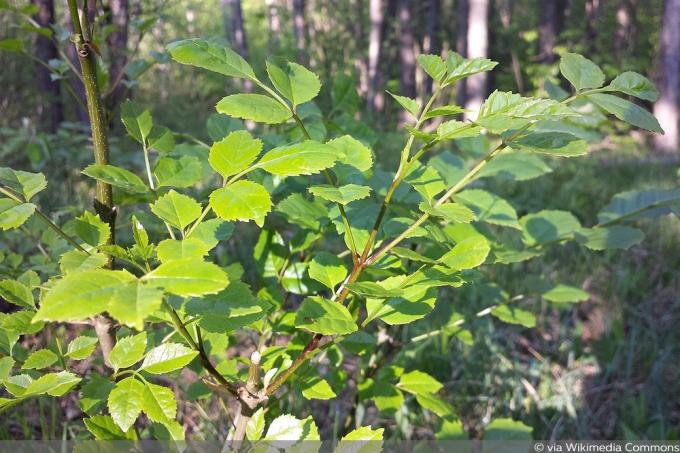
In contrast to the strong-growing native ash and other ash species, the also develops as Manna ash referred to flower ash to a height of only six to eight meters Small tree. The crown is round to conical, the conspicuously creamy white, fragrant panicles of flowers appear between May and June when the leaves are unfolding. This attractive flowering tree is small and is very suitable for gardens and courtyards, but can also be grown in large planters. It does best in sunny and warm locations.
2. Blood plum (Prunus cerasifera 'Nigra')

This very robust small tree scores with a striking, dark purple-red foliage. The fast-growing wood is only between five and seven meters high and develops a broad, conical to round crown with age. The blood plum is particularly attractive in March and April when the numerous pink flowers open. The dark red fruits ripen in September.
3. Japanese maple (Acer palmatum)
The Japanese maple, which is native to East Asia, is certainly one of the most attractive ornamental trees with its filigree leaves and delicate structure. Meanwhile there are numerous cultivars that find enough space even in the smallest gardens. As a solitaire near a pond, in inner courtyards or planted in large planters, the Japanese maples unfold their distinctive effect. They get along particularly well with Ferns, Grass, bamboo and other small trees.
The Japanese maple grows either in the shape of a tree or a shrub, with many varieties reaching heights of up to ten meters in old age. However, there is also a large selection of short varieties. Characteristic of all Acer palmatum are
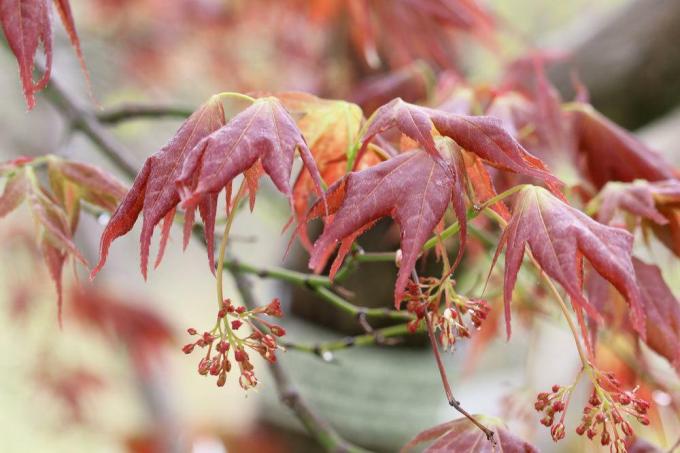
- the richly branched growth
- the delicate foliage
- the up to ten centimeters wide, finely lobed leaves
- as well as the different foliage colors
The foliage is mostly fresh green, but can also be intense red or yellow, depending on the variety. even be variegated. In addition, the leaves of all varieties take on a bright, yellow-orange to red autumn color in autumn.
Especially recommended varieties
The following types of Japanese maple remain particularly small:
- 'Atropurpureum': upright growth, height between six and eight meters, bright purple foliage
- 'Beni-hime': very delicate growth, height of only one meter, leaves when shoots wine-red and later green
- 'Corallinum': dainty growth, height between two and three meters, leaves initially bright pink, green in summer
- 'Crimson Queen': umbrella-shaped growth, height of up to two meters, leaves dark purple-red, bright scarlet red in autumn
- 'Wilson’s Pink Dwarf': weak growth, height up to 1.5 meters, leaves rose-red when they shoot, fresh green in summer
Tip: In addition to the Japanese maple, other Asian Acer species are also very suitable for the small garden. The Japanese golden maple (Acer shirasawanum) is only seven to nine meters high, the monkshood maple (Acer japonicum, the 'Aconitifolium' variety is particularly pretty with its bright orange-red leaves) even up to five meters.
4. Common Judas Tree (Cercis siliquastrum)
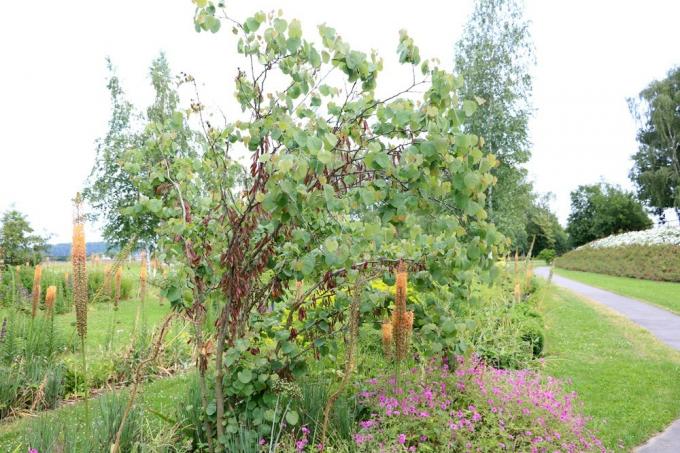
The Judas tree is a slow-growing, mostly multi-stemmed and deciduous dwarf tree that remains small with a height of between four and six meters. The species belongs to the early spring bloomers, as the purple-pink butterfly flowers, which are up to two centimeters long, open long before the leaves open. Unfortunately, the Judas tree is quite sensitive to frost and therefore thrives best in regions with mild winter conditions.
J to M
5. Japanese cherry (Prunus serrulata)
The different varieties of Prunus serrulata usually develop into upright growing small trees with ovoid to rounded crowns. Some varieties grow narrowly columnar, while others have branches overhanging in wide arches. The dark green leaves, often bronze-colored when they shoot, turn yellow to orange-red in autumn. Ornamental cherries bloom profusely between April and May with simple to double, white to pink-colored flowers. These small varieties are particularly attractive for the garden:

- 'Amanogawa': columnar growth, height six to eight meters, width of growth up to three meters
- 'Pink Perfection': broad, upright growth, up to five meters in height, hanging branches
- 'Royal Burgundy': broad, funnel-shaped growth, height between five and seven meters, crown up to five meters wide
- 'Shogetsu': umbrella-shaped, hemispherical growth, height of up to five meters
6. Canadian Judas Tree 'Forest Pansy' (Cercis canadensis 'Forest Pansy')

The 'Forest Pansy' variety is predominantly planted in our gardens from the little-known Canadian Judas tree. It is a slowly growing small tree between three and six meters high with several main branches and a rather spreading crown. This tree not only stays small, but also impresses with its unusual foliage color: the almost circular, Leaves up to twelve centimeters long are shiny purple-black when they shoot, later deep purple-red and finally dark green. The young leaf stalks and shoots are also purple-black in color. Another advantage is the frost hardiness of this variety, which incidentally is higher than that of the related common Judas tree.
7. Cornelian cherry (Cornus mas)
The Cornelian cherry is a native early spring bloomer that provides bees and other insects with valuable nectar and pollen during its flowering period. The fruits, which ripen in October, not only serve as food for the birds, but have also been considered healthy and versatile wild fruits for centuries. These properties are characteristic of the Cornelian cherry:

- slow growth
- Height between four and six meters
- Shrub or small tree
- broad, rounded crown
- Flowering in February / March
- edible fruits
- native species, therefore adapted to the Central European climate
Tip: If you value the fruit, choose large-fruited varieties that are as rich as possible, such as 'Jolico'. These were specially refined for this purpose.
8. Ball trumpet tree 'Nana' (Catalpa bignonioides 'Nana')
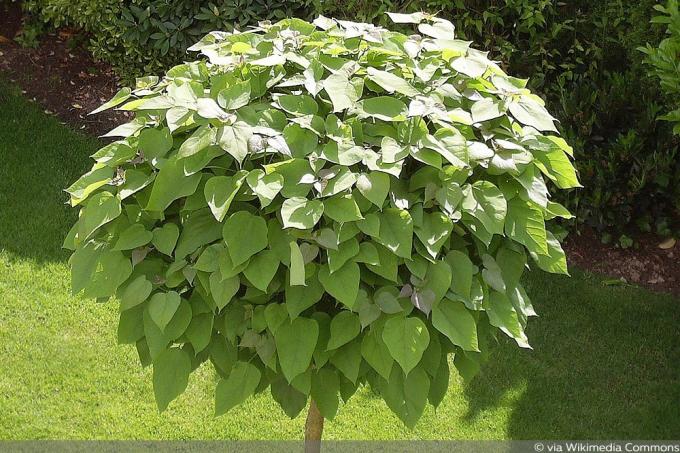
In contrast to the original species, the common trumpet tree, which can grow up to 18 meters high, the spherical trumpet tree reaches a very compact height of between four and six meters. In addition, its crown is not wide and sweeping, but spherical and therefore ideal for the small garden. Typical of the trumpet tree are the 10 to 15 centimeters long, richly branched and loose flower panicles. They appear in June and July. The bean-shaped fruits, which are up to 40 centimeters long, develop from them in autumn.
9. Magnolias (Magnolia)
Magnolias are without a doubt one of the most attractive flowering trees that have come to our gardens from East Asian countries. In the period from April to July, depending on the species, they surprise again and again with their abundance of flowers and the large, elegant flowers. In their size, they exceed the flowers of all other tree species in the temperate and subtropical zones. The creamy white, bowl-shaped flowers of the North American Magnolia macrophylla, the large-flowered magnolia, for example, can reach a diameter of up to 40 centimeters. In addition, many magnolias are also suitable for small gardens, as they are not particularly tall. These species and varieties remain rather small:
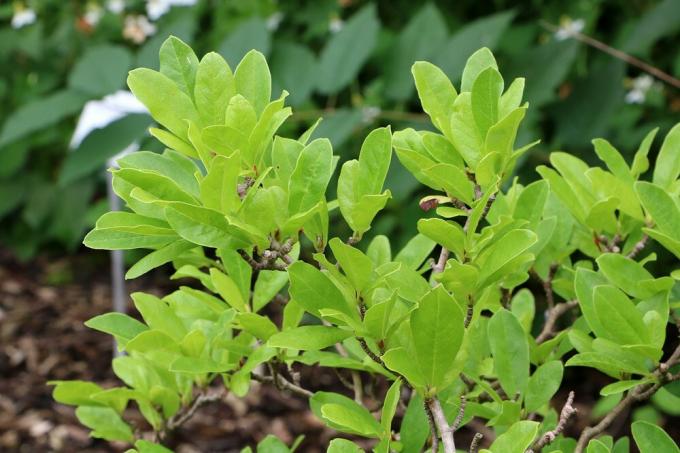
- Kobushi magnolia (Magnolia kobus): Height eight to ten meters, slow growth, rounded crown up to five meters wide, very robust
- Purple magnolia (Magnolia liliiflora 'Nigra'): Height between three and five meters, just as wide, more shrub-like growth except for the small tree-like varieties 'Galaxy' and 'Star Wars'
- Loebner's magnolia (Magnolia x loebneri 'Merill'): large shrub or small tree, height between four and six meters, conical crown
- Tulip magnolia (Magnolia x soulangiana): broadly spreading, short-stemmed small tree, height of growth up to six meters
- Star magnolia (Magnolia stellata): only up to three meters high, ideal for very small gardens
P to S
10. Pagoda dogwood (Cornus controversa)
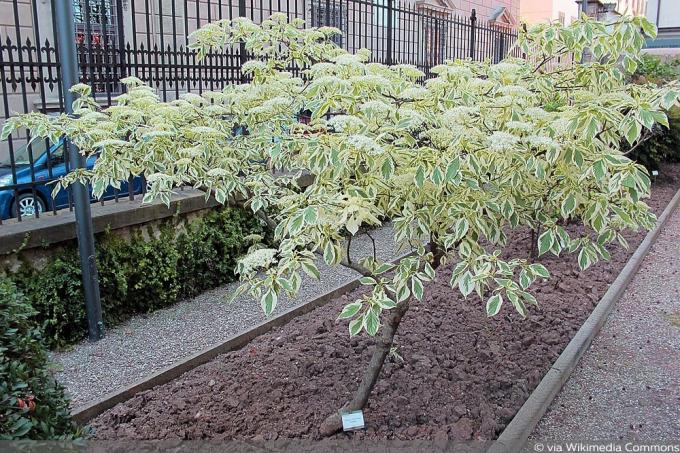
The pagoda dogwood develops into a rather small tree, only between eight and ten meters high. Characteristic of this elegant solitary tree are the horizontally protruding branches that are on top of each other on regular levels. They give the wood a very idiosyncratic, pagoda-like structure. The 'Variegata' variety grows significantly weaker than the species and also scores with its irregularly yellowish-white-edged leaves.
11. False beech (Nothofagus antarctica)
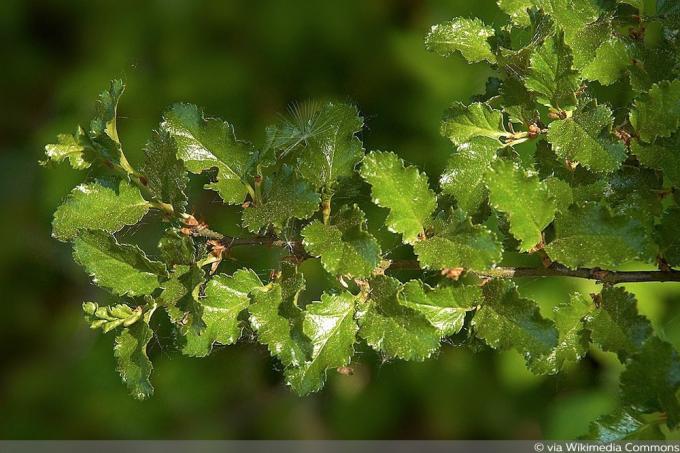
The false beech is a deciduous tree in the southern hemisphere that barely exceeds six meters in our country. The initially stiffly upright, later irregularly growing small tree impresses with its idiosyncratic and filigree structure and the blackish bark. It is well suited as a solitary tree and is also often planted in courtyards or near buildings. The leaves turn golden yellow in autumn.
12. Norway maple 'Globosum' (Acer platanoides 'Globosum')
The native Norway maple usually grows into a stately and broad-crowned tree with a height of up to 30 meters. The fast-growing species is therefore very popular as a park and avenue tree as well as in large gardens. But even if your garden is small and the tree therefore has to be small, you do not need to do without a house tree. The solution consists in the delicate cultivar 'Globosum', which with its spherical crown is wonderfully suitable for front or terraced gardens.

The Norway maple 'Globosum' only reaches a height of between four and seven meters. Its crown is spherical to flattened spherical and also not as broad-growing as that of the species. The five-lobed, glossy dark green leaves also remain significantly smaller - a real dwarf tree.
Tip: Also recommendable is the Norway maple 'Crimson Sentry', which has a narrow, columnar growth and is only up to ten meters high.
W to Z
13. Willow-leaved pear (Pyrus salicifolia 'Pendula')

The willow-leaved pear grows very slowly and also develops into a five to nine meter high, mostly short-stemmed tree with horizontally protruding or downwardly curved branches. In April, the small tree bears numerous white, two-centimeter-long flowers in small umbels. The two to three centimeters long, pear-shaped fruits are hard and inedible. This sturdy tree is very suitable for a solitary position in the garden.
14. Crabapple
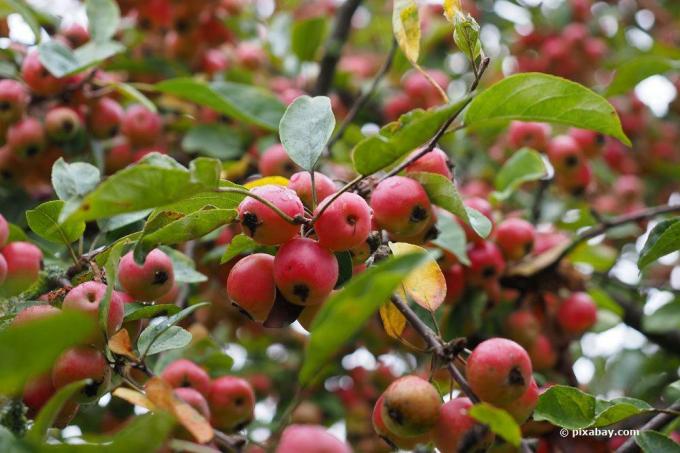
Ornamental apples are among the most attractive flowering trees in the garden, and they are often rather small. Numerous species and varieties not only delight us with an exuberant abundance of flowers in spring, but they also draw attention to themselves again in autumn with a rich fruit decoration. With some varieties, the small apples stick well into winter before they become crumbly and serve as bird food. These types and varieties are particularly attractive:
- Multi-flowered apple (Malus floribunda): Height four to ten meters, deciduous, broad, densely branched crown
- Japanese apple (Malus toringo): Height between five and six meters, broad, upright growth with widely protruding branches
- Malus hybrids: small trees between four and six meters high, often Malus floribunda hybrids, large selection of varieties
15. Dwarf birch (Betula nana)
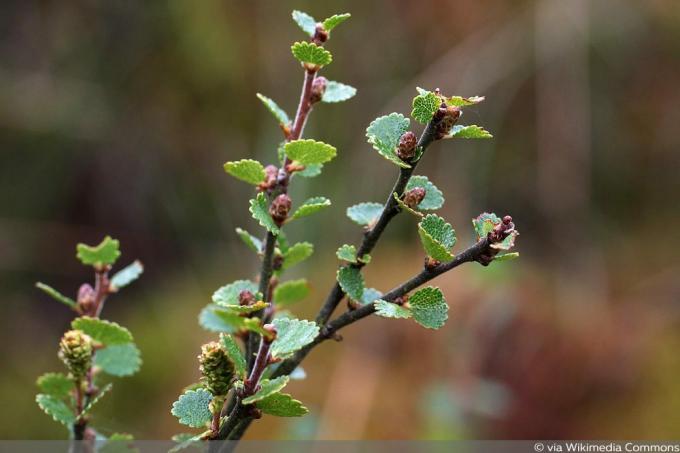
This pretty dwarf tree remains very small for its entire life. With its rather low-lying branches, it reaches heights of only 0.5 to one meter. Since the wood is at home in the moors of northern Europe and Siberia, it needs a wet, nutrient-poor soil. Ideal locations are therefore swamp and water gardens as well as stone and heather gardens.



